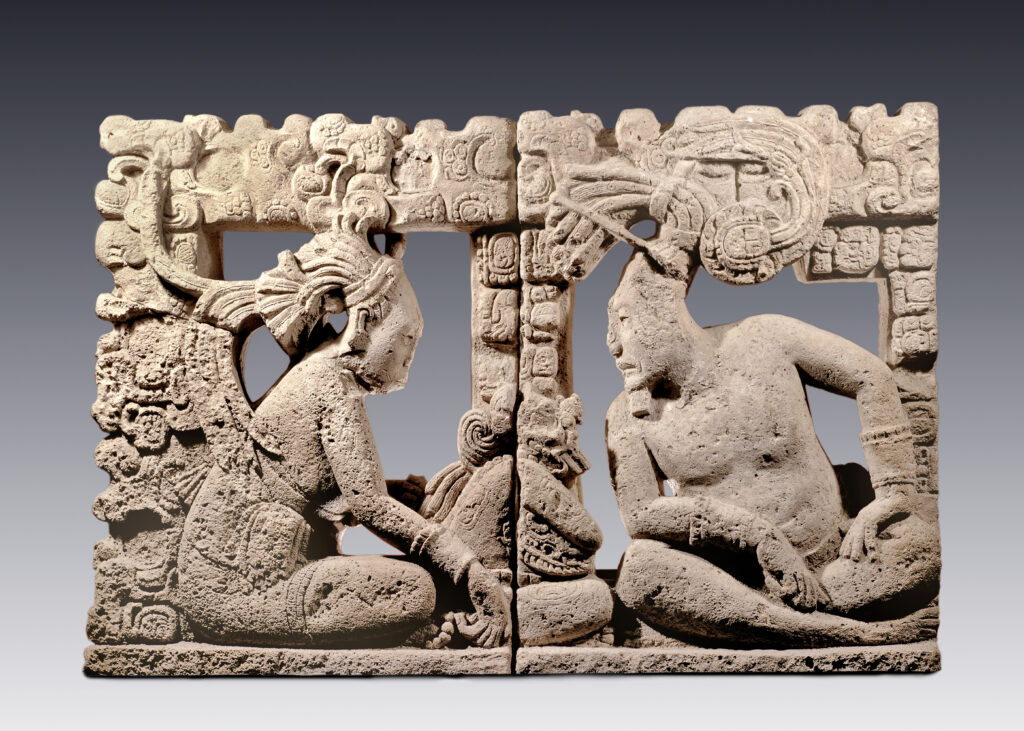Maya Gods Descend on Manhattan
Centuries after the conquistadores, immortal kings and gods are reincarnated, so to speak, at the Met.

The Mayans believed their gods to be immortal, and if “Lives of the Gods: Divinity in Mayan Art” is any indication, that faith was well founded. The show, at the Metropolitan Museum of Art until the beginning of April, captures a culture where the human, animal, and divine morphed and mingled. The Mayans were not possessed of the austere ratiocinations of Maimonides. Their gods had faces, passions, grudges. They live, still.
“Lives” — the first major exhibition of Maya art in the United States in a decade — covers the Classic period of Mayan civilization, which runs from 250 of the common era until 900. The Aztec and Inca empires were centuries away. The Mayans built cities embedded in the tropical rain forests that stretch over what is now Guatemala, Honduras, and Mexico. Two-thousand years before the common era, they learned how to coax stalks of maize from the earth.
The Met’s catalog informs that the Mayans “built a sacred landscape, with cities dominated by temples that rose on tall pyramidal platforms, which were conceived as houses for the gods.” They also knew how to write, their scribes chronicling conquests and supplications in coiled and twisted hieroglyphs that do double duty as image and idiom. Millions today speak Mayan languages, even as the Spanish conquest obliterated much of the old ways.
The Met is not a history museum, but one devoted to art, and the more than 100 objects assembled for “Lives” display a fusion of religious and aesthetic sensibilities that recalls the crucifixes and altarpieces of medieval Europe, gorgeous and godly. The Met tells us that the Mayan glyph k’uh means both deities and sacred objects, a convergence of artistic object and divine subject. The show’s curator, Joanne Pillsbury, has gathered a Mayan pantheon.
“Throne back” is a silhouette of a bearded lord speaking to a companion, both ensconced at a cave. Between them is a supernatural creature with the head of a jaguar and arms adorned with wings. The beast is apparently a messenger of the Mayan sky god Itzamnaaj. The man is both receiving word from the deity and impersonating him, offering a tantalizing glimpse of a haunted, role-playing mode of worship. The silhouette captures the sorcery.

Instituto Nacional de Antropología e Historia.
“Squared vessel,” of ceramic and stucco, depicts an old god smoking a cigar, lounging on a jaguar pelt, presiding over a conclave of 10 deities. A caption names the place and time: K’inchil, or “Great Sun Place,” on August 11, 3114, before the common era. That precise and remote date was venerated by the Mayans — who were enthralled by creation myths — as marking the origins of the cosmos.
“Panel Fragment,” of stone, depicts a warrior with full lips and forward lean, attired with a branched and curved headdress modeled after a centipede, replete with fangs. He wears a diadem, a signature of royalty, and scholars explain that his serpent-shaped nose ring is meant to convey the fiery breath of the Sun God, of whom he is an avatar. When the Mayans looked to the stars, they saw platoons of celestial armies engaged in astral warfare.
“Monument 168,” hewn of limestone, stands at more than eight and a half feet. Its subject is King Jaguar Bird Tapir, a fearsome monarch who ruled at a Mayan stronghold, Tonina, at the current day Mexican state of Chiapas. Stacked masks adorn his head, and his waist is cinched with a belt studded with the head of a jaguar. Glyphs recount his mighty deeds. One could imagine, even today, bending the knee to this Mayan Ozymandias.
“Monument 155” deploys sandstone to portray a captive in a paroxysm of pain. His body is twisted and his neck is torqued. An inscription names him as Yax Ahk, who ruled at Anaayte, a city on the banks of the Usamacinta River that snakes along the border between Mexico and Guatemala. He is impersonating the jaguar god, with a feline ear. The Mayans told — and lived — myths of a jaguar warrior captured and tortured when the world was young.
“Lives” is staged at a gallery adjacent to another show, “Tudors: Art and Majesty in Renaissance England.” Standing before King Jaguar Bird Tapir is good preparation for gazing at Elizabeth I. Ignore quibbles over space and time. Instead, daydream of the lord of Tonina paying a royal visit to the Virgin Queen. They do not share a language, but both are fluent in the power of images and the images of power. As long as kings and queens reign, artists will eat.

